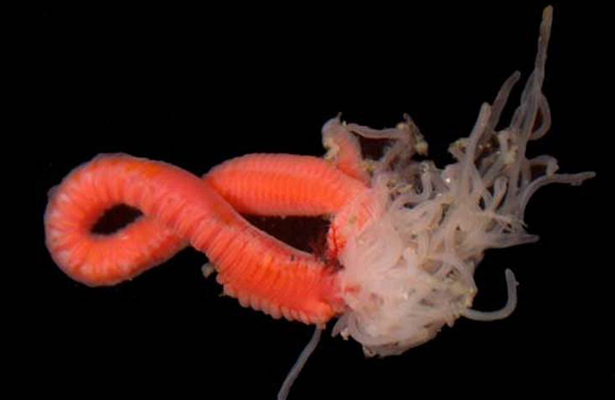A Radical Approach to Defense

When are free radicals good for you? When your next door neighbor produces a toxic chemical soup.
Behold the lowly marine worm, Amphitrite ornata. It’s red, looks like spaghetti and spends all of its time sifting through seafloor mud for meals. With absolutely zero defensive capabilities, Amphitrite would make an easy target for predators, yet it goes about its life relatively unscathed. How? Because Amphitrite ornata understands the old adage about real estate: location, location, location.
Amphitrite is usually found next to another marine worm, Notomastus lobatus, which produces a stream of toxic chemicals to drive away predators. Yet Amphitrite is unaffected by the toxic soup, because it’s able to detoxify itself. The way it does this, however, is what interests scientists, since removing toxins from water would have tremendous environmental benefits. The key to Amphitrite ornata’s detoxification ability is its hemoglobin – a protein that performs two very different functions at the same time, and utilizes a radical to make it happen.
In mammals and most other living organisms, hemoglobin’s only function is to move oxygen around. In Amphitrite ornata, however, hemoglobin not only transports oxygen, it also performs chemical detoxification within the organism. Why is this unusual? Because the way our bodies have evolved, enzymes have become specialized to perform a single task well, rather than several tasks competently. So you don’t see oxygen transportation and detoxification performed by the same enzyme in higher organisms.
Unlike mammals, Amphitrite has one enzyme – dehaloperoxidase – that manages to perform both functions of oxygen transport and chemical detoxification, but that’s not all. It also uses radicals – popularly known as those invisible evil things that cause premature aging – in the detoxification process. By using radicals for a beneficial purpose, rather than spending energy fighting against them, Amphitrite’s hemoglobin makes the best out of a bad situation by pitting the radical against the toxins. The type of radical Amphitrite produces is slower to decay, more stable and less likely to damage the organism when the toxic chemicals it’s supposed to be scrubbing aren’t present.
According to NC State chemist Reza Ghiladi, these oddities are what make a lowly worm worthy of study. “In the case of Amphitrite, nature has found a way to decrease the reactivity of a radical and make it last longer – slowing its self-destructive nature, and helping to save the organism by allowing it to use this radical to remove toxins without harming itself. This enzyme may also be a useful tool in cleaning up certain pollutants produced as waste products of the chemical industry, or by the military – like Agent Orange – that cannot be disposed of easily.”
- Categories:


